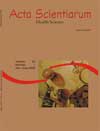Fadiga neuromuscular induzida por d-Tubocuranina, Hexametônio e Neostigmina em preparações nervo frênico-diafragma isolado de ratos diabéticos
Abstract
The acetylcholine released from motor nerve terminal (MNT) can regulate its own output (MNT automodulation) acting on nicotinic (positive feed back automodulation) or muscarinic (negative feedback automodulation) presynaptic receptors. On the other hand, diabetic neuropathy, a disorder of peripheral nerves, is one of the most common complication of diabetes mellitus that produces serious alterations on motor nerve terminal without interfering in the velocity and integrity of neuro-muscular transmission. Pharmacological studies have shown that diabetic animals are less sensitive to some neuromuscular blockades such as d-tubocurarine, galamine, pancuronium or decamethonium than normal ones. Results suggest that change in MNT automodulation may counterbalance neuronial deficiencies induced by diabetes. The present study with phrenic nerve-diaphragm preparations from normal and diabetic animals was conducted to verify whether differences in neuro-muscular fade induced by d-tubocurarine, hexametonium or neostimine exist. Results showed that there were no differences in neuro-muscular fade induced by neostigmine, hexametonium or d-tubocurarine. However, the recovery of tetanic fade induced by d-tubocurarine was faster in preparations obtained from diabetic rats. Difference might be explained by decrease in affinity of d-tubocurarine for presynaptic nicotinic receptors.Downloads
Download data is not yet available.
Published
2008-07-21
How to Cite
Tagliari, L. M., & Prado, W. A. do. (2008). Fadiga neuromuscular induzida por d-Tubocuranina, Hexametônio e Neostigmina em preparações nervo frênico-diafragma isolado de ratos diabéticos. Acta Scientiarum. Health Sciences, 20, 231-234. https://doi.org/10.4025/actascihealthsci.v20i0.4480
Issue
Section
Health Sciences
DECLARATION OF ORIGINALITY AND COPYRIGHTS
I Declare that current article is original and has not been submitted for publication, in part or in whole, to any other national or international journal.
The copyrights belong exclusively to the authors. Published content is licensed under Creative Commons Attribution 4.0 (CC BY 4.0) guidelines, which allows sharing (copy and distribution of the material in any medium or format) and adaptation (remix, transform, and build upon the material) for any purpose, even commercially, under the terms of attribution.
Read this link for further information on how to use CC BY 4.0 properly.























5.png)







